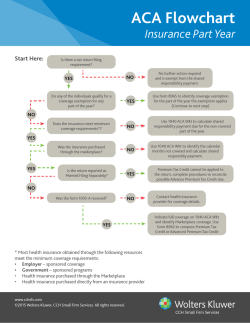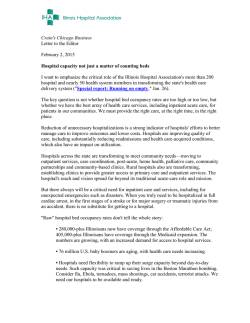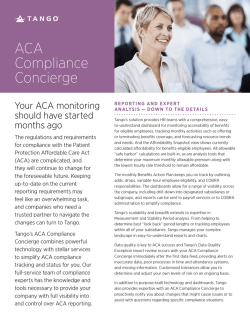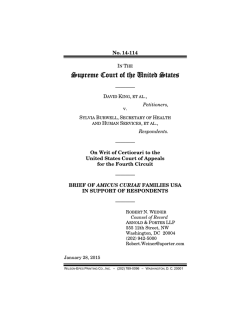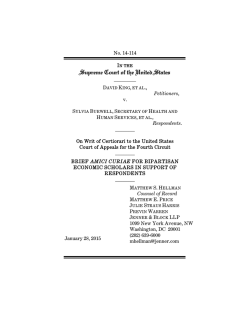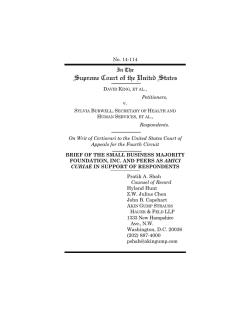
Supreme Court of the United States
No. 14-114 In the Supreme Court of the United States _________________________________________ DAVID KING, ET AL., v. Petitioners, SYLVIA BURWELL, SECRETARY OF HEALTH AND HUMAN SERVICES, ET AL., Respondents. _________________________________________ On Writ Of Certiorari To The United States Court Of Appeals For The Fourth Circuit _________________________________________ BRIEF OF THE CATHOLIC HEALTH ASSOCIATION OF THE UNITED STATES AND CATHOLIC CHARITIES USA AS AMICI CURIAE IN SUPPORT OF RESPONDENTS _________________________________________ Lisa J. Gilden THE CATHOLIC HEALTH ASSOCIATION OF THE UNITED STATES 1875 Eye St. N.W. Suite 1000 Washington, DC 20006 JANUARY 28, 2015 Christopher J. Wright Counsel of Record Stephen W. Miller HARRIS, WILTSHIRE & GRANNIS LLP 1919 M Street N.W., Eighth Floor Washington, DC 20036 (202) 730-1300 [email protected] i TABLE OF CONTENTS Page TABLE OF AUTHORITIES ........................................ii INTEREST OF AMICI CURIAE ................................ 1 INTRODUCTION AND SUMMARY OF ARGUMENT ............................................................... 4 ARGUMENT ............................................................... 7 I. The ACA Makes Tax Credits Available To Low and Moderate Income Americans Regardless of the State in which They Live. ...................... 7 II. Eliminating Subsidies on FederallyFacilitated Exchanges would have Devastating Consequences for Catholic Hospitals, Their Patients, and the Communities They Serve. .............................. 14 CONCLUSION .......................................................... 22 ii TABLE OF AUTHORITIES Cases Page(s) Abramski v. United States, 134 S. Ct. 2259 (2014) ................................ 6, 11, 13 Chevron U.S.A. Inc. v. NRDC, Inc., 467 U.S. 837 (1984) .......................................... 6, 12 Mayo Found. For Medical Educ. & Research v. United States, 131 S. Ct. 704 (2011) ................... 13 Mobile Comm’s Corp. v. FCC, 77 F.3d 1399 (1996) . 14 National Ass’n of Home Builders v. Defenders of Wildlife, 551 U.S. 664 (2007) ............................... 11 National Fed’n of Indep. Bus. v. Sebelius, 132 S. Ct. 2566 (2012) ......................................... 4, 7, 9, 13, 15 Robinson v. Shell Oil Co., 519 U.S. 337 (1997) ........ 11 Util. Air Regulatory Grp. v. EPA, 134 S. Ct. 2427 (2014) .................................................................... 10 Statues and Other Legislative Authorities 26 C.F.R. § 1.36B–1 ............................................... 6, 12 26 C.F.R. § 1.36B–2 ............................................... 6, 12 26 U.S.C. § 36B...................................... 5, 9, 10, 12, 13 26 U.S.C. § 5000A.................................................... 4, 8 42 U.S.C. § 300gg .................................................... 4, 8 42 U.S.C. § 300gg-1 ................................................. 4, 8 iii 42 U.S.C. § 300gg-2 ................................................. 4, 8 42 U.S.C. § 300gg-3 ................................................. 4, 8 42 U.S.C. § 300gg-4 ................................................. 4, 8 42 U.S.C. § 18031 .................................................. 5, 11 42 U.S.C. § 18041 .............................................. 5, 8, 11 157 Cong. Rec. S737 (daily ed. Feb. 15, 2011) (statement of Senator Franken) ............................ 9 Patient Protection and Affordable Care Act, Pub. L. No. 111-148, 124 Stat. 119 (2010) ......................... 4 Other References A. Burke, et al., ASPE Research Brief: Premium Affordability, Competition, and Choice in the Health Insurance Marketplace, 2014, (Dep’t of Health and Human Servs., June 18, 2014) ..... 9, 15 American Hosp. Ass’n, Summary of 2010 Health Care Reform Legislation (Apr. 19, 2010) ............. 19 American Hosp. Ass’n, Uncompensated Hospital Care Cost Fact Sheet (Jan. 2014)......................... 18 ASPE Issue Brief: How Many Individuals Might Have Marketplace Coverage After the 2015 Open Enrollment Period? (Dep’t of Health & Human Servs., Nov. 10, 2014). ......................................... 15 B. Semro, Potential Impacts of New Federal Policies on Provider Reimbursement Rates (The Bell Policy Center, Nov. 1, 2011) ................................ 19 iv C. Babcock, Uninsured Americans Get Hit With Biggest Hospital Bills, Bloomberg, Mar. 11, 2013 ................................................. 16, 17 Catholic Health Ass’n, Catholic Health Care in the United States Fact Sheet (Jan. 2015) .......... 1, 3 Changes in Health Care Financing & Org., Challenges Facing the Health Care Safety Net (Feb. 2008) ............................................................ 18 Congressional Budget Office, An Analysis of Health Insurance Premiums Under the Patient Protection and Affordable Care Act, (Nov. 30, 2009) ............................................... 13, 15 E. Saltzman, Eibner, C., The Effect of Eliminating the Affordable Care Act’s Tax Credits in Federally Facilitated Marketplaces (Rand Corp., 2015) ..... 16 Institute of Med., America’s Health Care Safety Net: Intact but Endangered (The National Academic Press, 2000) ...................................................... 8, 18 J. Hadley, et al., Covering the Uninsured In 2008: Current Costs, Sources of Payment, & Incremental Costs, (Henry J. Kraiser Family Foundation, Aug. 25, 2008) ................................... 8 L. Blumberg, et al., Characteristics of Those Affected by a Supreme Court Finding for the Plaintiff in King v. Burwell (Urban Institute, Jan. 2015) ..................................................................... 17 L. Blumberg, et al., The Implications of a Supreme Court Finding for the Plaintiff in King v. Burwell: 8.2 Million More Uninsured and 35% Higher Premiums (Urban Institute, Jan. 2015) .............. 16 v Open Enrollment Week 9: January 10, 2015 – January 16, 2015, Dept. of Health and Human Servs. Blog (January 21, 2015) http://www.hhs.gov/healthcare/facts/blog/2015/01/ open-enrollment-week-nine.html. ........................ 9 Pope John XXIII, Pacem in Terris (Apr. 11, 1963) ... 2 Press Release, U.S. Dep’t of Health & Human Servs., New Data Say Uninsured Account for Nearly One-Fifth of Emergency Room Visits (July 15, 2009) ................................. 8, 17, 18 S.M. Miller, Robert Wood, Johnson Foundation, The ACA Helps Correct Incentives for Patients to Use the Health Insurance System Inefficiently (Aug. 30, 2013) ............................................................... 17 Sr. Carol Keehan, Sisters of Charity Health System, Remarks at Cleveland City Club: Next Steps for the Affordable Care Act (Aug. 17, 2012) ........ 19, 20 T. Coughlin, et al., Strategies in 4 Safety-Net Hospitals to Adapt to the ACA (The Kaiser Comm’n on Medicaid and the Uninsured, June 2014) ............................................................ 20 The Kaiser Comm’n on Medicaid & the Uninsured, The Uninsured & The Difference Health Care Makes (Sept. 2010) ............................................... 17 The Kaiser Comm’n on Medicaid and the Uninsured, Uncompensated Care for Uninsured in 2013: A Detailed Examination (The National Academic Press, May 30, 2014) ............................................ 18 vi U.S. Conference of Catholic Bishops, Ethical and Religious Directives for Catholic Health Care Services, (5th ed. Nov. 17, 2009) ............................ 3 1 INTEREST OF AMICI CURIAE1 The Catholic Health Association of the United States and Catholic Charities USA respectfully submit this brief as amici curiae. The Catholic Health Association of the United States is the national leadership organization for the Catholic health ministry in the United States. Consisting of more than 600 hospitals and 1,400 long term care and other health facilities in all 50 states, the Catholic health ministry is the largest group of nonprofit health care providers in the nation. One in six hospital patients in the United States receives care in a Catholic hospital,2 and those hospitals serve a high percentage of poor, low income, and underinsured Americans. Catholic Charities USA is the national office for Catholic Charities agencies nationwide. For more than 100 years it has guided and supported the vast network of Catholic Charities agencies nationwide in a common mission to provide service to people in Pursuant to SUP. CT. R. 37.3(a), amici certify that both parties have given blanket consent to the filing of amicus briefs in support of either party. Pursuant to SUP. CT. R. 37.6, amici certify that no counsel for any party authored this brief in whole or in part, no party or party’s counsel made a monetary contribution to fund its preparation or submission, and no person other than amici or their counsel made such a monetary contribution. 1 Catholic Health Ass’n, Catholic Health Care in the United States Fact Sheet, (Jan. 2015) available at http://www.chausa.org/docs/default-source/generalfiles/cha_miniprofile_final.pdf?sfvrsn=0. 2 2 need, to advocate for justice in social structures, reduce poverty, support families, and empower communities. In 2014, Catholic Charities agencies provided a wide range of services to over 9 million poor and needy persons, and saw firsthand the devastating impact on individuals and families of not having access to affordable healthcare. Amici’s missions are informed by Catholic social teaching, which is grounded in a respect for human dignity and instructs that health care is a basic human right essential to human flourishing.3 Amici believe that a just society requires taking care of vulnerable and marginalized populations, such as those who lack health care coverage. Indeed, the Catholic health ministry seeks to distinguish itself by serving and advocating “for those people whose social conditions puts them at the margins of our society and makes them particularly vulnerable to discrimination: the poor; the uninsured and the underinsured; children and the unborn; single parents; the elderly; those with incurable diseases and chemical dependencies; racial minorities; See Pope John XXIII, Pacem in Terris, para. 11 (Apr. 11, 1963) (“Man has the right to live. He has the right to bodily integrity and to the means necessary for the proper development of life, particularly food, clothing, shelter, medical care, rest, and, finally, the necessary social services. In consequence, he has the right to be looked after in the event of ill health; disability stemming from his work; widowhood; old age; enforced unemployment; or whenever through no fault of his own he is deprived of the means of livelihood.”). 3 3 immigrants and refugees.”4 Catholic hospitals are more likely to provide public health and specialty services, such as HIV/AIDS care, children’s wellness and neonatal ICU, despite the often negative financial implications.5 In advancing their mission, Catholic hospitals and Catholic Charities agencies have witnessed firsthand the devastating impact of the lack of affordable health insurance and health care on vulnerable members of our society. The Catholic Health Association therefore advocated for the passage of the Patient Protection and Affordable Care Act (ACA or Act), which expands health care coverage to those without it in all 50 states and decreases the cost to society of providing health care. Subsidies provided by the ACA enable more Americans to obtain health insurance and therefore are integral to the Act’s aims. Limiting those subsidies would have a tremendously negative effect on the ministry’s mission and millions of low and moderate income Americans who have already benefitted from increased access to health care. U.S. Conference of Catholic Bishops, Ethical and Religious Directives for Catholic Health Care Services at 11, Nov. 17, 2009 (5th ed.). 4 Catholic Health Ass’n, Catholic Health Care in the United States Fact Sheet, (Jan. 2015) available at http://www.chausa.org/docs/default-source/generalfiles/cha_miniprofile_final.pdf?sfvrsn=0. 5 4 INTRODUCTION AND SUMMARY OF ARGUMENT 1. Congress enacted the Patient Protection and Affordable Care Act, Pub. L. No. 111-148, 124 Stat. 119 (2010), “to increase the number of Americans covered by health insurance and decrease the cost of health care.” Nat’l Fed’n of Indep. Bus. v. Sebelius, 132 S. Ct. 2566, 2580 (2012) (NFIB). In doing so, Congress addressed both (a) the problem that millions of Americans lacked sufficient health coverage or any way to pay for it, and (b) the problem that hospitals that provided emergency care and other medical care to the uninsured or underinsured incurred billions of dollars in uncompensated care costs. Indeed, before the ACA, uninsured Americans annually made more than 20 million trips to hospital emergency rooms and received just shy of $100 billion in health care services. Although some of the uninsured were able to pay for a portion of the care they received, much of the cost was passed along to hospitals—in particular, hospitals, like many associated with the Catholic health ministry, that serve vulnerable patient populations. Congress designed the ACA to address these related issues. The ACA has three primary components that work in concert to achieve its goals. First, the ACA prohibits insurance companies from denying coverage or charging higher premiums based on a person’s medical condition or history. 42 U.S.C. §§ 300gg–300gg4. Second, the ACA’s individual mandate requires individuals who are not covered by an employer’s insurance policy to purchase minimum coverage. 26 U.S.C. § 5000A. The Act further 5 provides for the establishment of health insurance exchanges on which individuals may purchase the required health insurance. States themselves can choose to establish an exchange, but if they do not, the federal government will establish such an exchange in those states. 42 U.S.C. §§ 18031(b), 18041(c). And third, the ACA provides subsidies for low and moderate income individuals to purchase insurance on these exchanges. 26 U.S.C. § 36B. In 2014, approximately 7 million people purchased health insurance through an exchange, and 5.4 million of them made their purchase through a federally-facilitated exchange. These numbers are increasing in 2015—to date, more than 7 million people have enrolled or reenrolled in health insurance coverage through a federally-facilitated exchange. Subsidies for insurance purchased on a federallyfacilitated exchange are designed to help the most vulnerable throughout our nation obtain health insurance and thus are integral to the law’s effectiveness. Nevertheless, Petitioners contend that subsidies are available only to individuals who obtain their insurance on an exchange established by a state directly rather than one established by the federal government in the state’s stead. Without providing any evidence in support of the claim that Congress intended this result, they argue that isolated snippets of the law actually function as a poison pill that Congress tucked away in the Act, without notice to anyone, in order to doom the law. In doing so, Petitioners miss the forest for the trees and choose to ignore the broader structure of 6 the law that makes clear that subsidies are available for insurance purchased on the federally-facilitated exchanges. Their position thus violates the venerable canon of statutory interpretation that a statute’s text must be considered “not in a vacuum, but with reference to the statutory context, ‘structure, history, and purpose.’” Abramski v. United States, 134 S. Ct. 2259, 2267 (2014) (quoting Maracich v. Spears, 133 S. Ct. 2191, 2209 (2013)). Furthermore, even if the language Petitioners cite, taken in context with the entire ACA, creates ambiguity regarding the availability of subsidies, the IRS permissibly interpreted the ACA through noticeand-comment rulemaking and determined that subsidies are available for insurance purchased on federally-facilitated exchanges. 26 C.F.R. 1.36B-1(k), 1.36B-2(a). This was an appropriate exercise of authority and is due deference under Chevron U.S.A. Inc. v. NRDC, Inc., 467 U.S. 837 (1984) (Chevron). 2. The consequences of eliminating the subsidies for insurance purchased on federally-facilitated exchanges should not be minimized. By one measure, enrollment in ACA-compliant plans sold in these marketplaces would decline by 70 percent. Meanwhile, unsubsidized premiums in these same states would increase 47 percent, which would correspond to a $1,610 annual increase for a 40 year old nonsmoker purchasing a “silver” plan. Moreover, these states have higher proportions of low-income people who are less able to obtain insurance without subsidies and thus are likely to go uninsured. Without the subsidies the cost of caring for the uninsured would again fall more heavily on 7 hospitals. Uncompensated care costs for hospitals in 2012 was $45.9 billion, or 6% of total expenses. Notably, in one of the original compromises leading to the ACA, hospitals accepted $155 billion in reimbursement cuts predicated on 30-32 million newly insured persons; trying to absorb those cuts without the corresponding increase in coverage from the exchanges would be devastating, especially for hospitals that serve a disproportionately vulnerable population. These “safety net” hospitals, many of which are associated with the Catholic health ministry, will still provide a significant portion of these services as part of their charity care. But in doing so they will have to shoulder the cost burden of treating uninsured individuals, which in turn will limit their ability to assist others in need. ARGUMENT I. The ACA Makes Tax Credits Available To Low and Moderate Income Americans Regardless of the State in which They Live. 1. Congress enacted the ACA “to increase the number of Americans covered by health insurance and decrease the cost of health care.” NFIB at 2580. Congress was reacting to two related problems— millions of Americans lacked sufficient health coverage or any way to pay for it, and hospitals that provided emergency and other medical care to the uninsured or underinsured incurred billions of dollars in uncompensated care costs. Prior to the ACA, the Department of Health and Human Services calculated that uninsured Americans accounted for nearly one-fifth of the total trips to hospital emergency rooms, which in 2006 equated to more 8 than 20 million visits. Press Release, U.S. Dep’t of Health & Human Servs., New Data Say Uninsured Account for Nearly One-Fifth of Emergency Room Visits (July 15, 2009). In 2008, those visits led to the uninsured receiving $86 billion in health care services. J. Hadley et al., Covering the Uninsured In 2008: Current Costs, Sources of Payment, & Incremental Costs 66 (The Henry J. Kaiser Family Found., Aug. 25, 2008). Although some uninsured were able to pay for a portion of the care they received, much of the costs were passed along to hospitals—in particular, hospitals, like many in the Catholic ministry, that serve a substantial share of vulnerable patients. Institute of Med., America’s Health Care Safety Net: Intact but Endangered (The National Press, 2000). Congress designed the ACA to address these related issues. The ACA has three primary components that work in concert to effectuate these goals. First, the ACA prohibits insurance companies from denying coverage or charging higher premiums based on a person’s medical condition or history. 42 U.S.C. §§ 300gg–300gg4. Second, the ACA requires individuals who are not covered by an employer’s insurance policy to purchase minimum coverage or pay a tax penalty (individual mandate). 26 U.S.C. § 5000A. The Act further provides for the establishment of health insurance exchanges on which individuals may purchase the required health insurance. States themselves can choose to establish an exchange, but if they do not, the federal government will establish such an exchange on the states’ behalf in that state. 42 U.S.C. §§ 18041(b), 18041(c). And third, the ACA provides subsidies for 9 low and moderate income individuals to purchase insurance on these exchanges. 26 U.S.C. § 36B. Early enrollment calculations for 2015 indicate that approximately 7.1 million people already have purchased health insurance through a federallyfacilitated exchange. Open Enrollment Week 9: January 10, 2015 – January 16, 2015, Dep’t of Health & Human Servs. Blog (January 21, 2015).6 This is an increase from the 5.4 million individuals who made their purchase through a federallyfacilitated exchange in 2014. A. Burke et al., ASPE Research Brief: Premium Affordability, Competition, and Choice in the Health Insurance Marketplace, 2014 3 (Dep’t of Health & Human Servs., June 18, 2014). The three components are designed to work together or not at all. See 157 Cong. Rec. S737 (daily ed. Feb. 15, 2011) (statement of Senator Franken) (describing the three “legs” of the statute and noting “[i]f you take any leg out, the [ACA] collapses”). For instance, if Congress had enacted only the rules requiring insurers to provide coverage on nondiscriminatory terms, with nothing more, it would have incentivized consumers to wait to purchase health insurance until they needed care. This would result in the oft-referenced “death spiral” of the reform. See NFIB, 132 S. Ct. at 2614 (Ginsburg, J., concurring in part and dissenting in part). However, on account of the individual mandate insurers do not face the adverse selection problem Available at http://www.hhs.gov/healthcare/facts/blog/2015/01/openenrollment-week-nine.html. 6 10 that leads to the “death spiral.” But those two reforms standing alone were not sufficient— Congress also provided for subsidies to make insurance broadly affordable. The subsidies under the ACA are designed to help the most vulnerable in our society obtain health insurance and thus are integral to the law’s effectiveness. Nevertheless, Petitioners argue that subsidies are available only for individuals who obtained their insurance “through an Exchange established by the State under [42 U.S.C. § 18031].” 26 U.S.C. § 36B(b)(2)(A). Petitioners contend that this section, read in isolation, means that subsidies are available exclusively to qualifying individuals who purchase insurance on an exchange established directly by a state and not on one established by the federal government on behalf of a state. Offering no evidence that Congress intended this result but acknowledging that a ruling from this Court in their favor would gut the ACA, they still argue that § 36B functions as a poison pill that Congress tucked away in the Act—without notice to anyone (including the states)—to doom the entire law. Petitioners miss the forest for the trees and choose to ignore the broader structure of the law that makes clear that subsidies are available for insurance purchased on the federally-facilitated exchanges. To get there, they would have this Court violate “the fundamental canon of statutory construction that the words of a statute must be read in their context and with a view to their place in the overall statutory scheme.” Util. Air Regulatory Grp. v. EPA, 134 S. Ct. 2427, 2441 (2014) (internal 11 citation omitted). Specifically, Petitioners would have this Court consider § 36B “in a vacuum, [and not] with reference to the statutory context, ‘structure, history, and purpose.’” Abramski, 134 S. Ct. at 2267 (quoting Maracich v. Spears, 133 S. Ct. 2191, 2209 (2013)). This Court, however, does not confine itself to a rigidly narrow view of the statutory language. Indeed, “[t]he plainness or ambiguity of statutory language is determined by reference to the language itself, the specific context in which that language is used, and the broader context of the statute as a whole.” Robinson v. Shell Oil Co., 519 U.S. 337, 341 (1997); Nat’l Ass’n of Home Builders v. Defenders of Wildlife, 551 U.S. 644, 666 (2007) (“[T]he meaning— or ambiguity—of certain words or phrases may only become evident when placed in context.”). An examination of the statutory scheme and consideration of the text of the law as a whole makes clear that Congress intended to, and did, provide that subsidies would be available for insurance purchased on federally-facilitated exchanges. The key lies in how the ACA establishes exchanges. One section of the Act provides that “Each State shall . . . establish an American Health Benefits Exchange.” 42 U.S.C. § 18031(b)(1). Meanwhile, in another section designed to afford “State flexibility,” 42 U.S.C. § 18041, the ACA provides two options: the first is that a state itself may create its exchange, id. § 18041(b); the second is that, if a state elects not to establish its own “required Exchange,” then the federal government will “establish and operate such Exchange within the State,” id. § 18041(c)(1) (emphasis added). A plain reading of the text of § 18041(c)(1) shows that, for purposes of the ACA, a 12 federally-facilitated exchange under § 18041(c)(1) is exactly the same as a state-established exchange under § 18031(b)(1). Put differently, the ACA provided that an exchange would be established in each state, but Congress gave states the flexibility either to tailor their own or to allow the federal government to establish one for them. The exchange itself, regardless of which particular entity established it, would be the same “required Exchange” under the ACA. Harmonizing these sections in light of the ACA’s stated purpose of expanding health insurance coverage and decreasing its costs, the text establishes that a federally-facilitated exchange established in a state that chooses not to create its own is indeed an “Exchange established by the State.” And under 26 U.S.C. § 36B(b)(2)(A), policies purchased on these exchanges are eligible for subsidies. Any other reading thwarts the intent of the Act by gutting the exchanges designed to deliver the needed reforms.7 2. The IRS permissibly interpreted the ACA through notice-and-comment rulemaking and determined that subsidies are available for insurance purchased on federally-facilitated exchanges. 26 C.F.R. 1.36B-1(k), 1.36B-2(a). This was an appropriate exercise of authority and is due deference under Chevron U.S.A. Inc. v. NRDC, Inc., 467 U.S. 837 (1984). The Government ably points out (Gov’t Br. at 27-34, 51-54) the various absurdities and incongruities Petitioners’ reading would create throughout the ACA. 7 13 Under the familiar Chevron framework, when a statute is susceptible to multiple interpretations this Court defers to an agency’s interpretation as long as it is based on a permissible construction of the statute. Chevron, 467 U.S. at 843. An agency reading that “give[s] effect to the statutory provisions, allowing them to accomplish their manifest objects,” Abramski, 134 S. Ct. at 2269, is permissible while a reading that renders illusory a statute’s promises is not. Chevron deference is no less appropriate where the question arises in the tax context. See Mayo Found. For Medical Educ. & Research v. United States, 131 S. Ct. 704, 713 (2011). The IRS has the authority under the ACA to interpret 26 U.S.C. § 36B(b)(2)(A). 26 U.S.C. § 36B(g) (“The Secretary shall prescribe such regulations as may be necessary to carry out the provisions of this section.”). Its reading of the statute clearly furthers what this Court has recognized as the broad policy goals of the ACA: “to increase the number of Americans covered by health insurance and decrease the cost of health care.” NFIB, 132 S. Ct. at 2580. And as the Congressional Budget Office (CBO) advised Congress while it was debating the ACA, “[t]he substantial premium subsidies available in the exchanges would encourage the enrollment of a broad range of people,” and that subsidies “would dampen the chances that a cycle of rising premiums and declining enrollment would ensue.” CBO, An Analysis of Health Insurance Premiums Under the Patient Protection and Affordable Care Act 19–20 (Nov. 30, 2009). As explained above, the best reading of the text and structure of the ACA is that subsidies are available on federally-facilitated exchanges. At 14 the least, that is a permissible construction of the statute. Petitioners’ argument to the contrary is essentially an expressio unius est exclusio alterius argument—the inclusion of a requirement for subsidies on one kind of exchange clearly means that Congress prohibited subsidies in another type. But as Judge Williams explained, “the maxim has little force in the administrative setting, where [courts] defer to an agency’s interpretation of a statute unless Congress has directly spoken to the precise question at issue.” Mobile Comm’s Corp. v. FCC, 77 F.3d 1399, 1404–05 (1996) (citations omitted). Congress did not clearly say that subsidies are not available on federally-facilitated exchanges. Accordingly, the IRS’s interpretation of the statute, which is necessary to ensuring that its purposes are fulfilled, should not be overturned. II. Eliminating Subsidies on FederallyFacilitated Exchanges would Have Devastating Consequences for Catholic Hospitals, Their Patients, and the Communities They Serve. 1. As noted above, the ACA’s goal of expanding health care coverage depends on three interdependent reforms: (1) insurers must provide coverage to all on nondiscriminatory terms; (2) individuals must buy health insurance; and (3) health care exchanges will provide subsidies for those who do not qualify for Medicaid but need assistance to buy insurance. It is thus no exaggeration that a decision from this Court holding that subsidies are not permitted 15 for insurance purchased on the federally-facilitated exchanges would devastate the ACA. Four members of this Court expressly acknowledged as much: “Without the federal subsidies, individuals would lose the main incentive to purchase insurance inside the exchanges, and some insurers may be unwilling to offer insurance inside of exchanges. With fewer buyers and even fewer sellers, the exchanges would not operate as Congress intended and may not operate at all.” NFIB, 132 S. Ct. at 2674 (Scalia, Kennedy, Thomas, and Alito, JJ., dissenting). Moreover, the majority of insurance policies purchased through ACA exchanges have been obtained through those that are federally-facilitated. Compare A. Burke et al., ASPE Research Brief: Premium Affordability, Competition, and Choice in the Health Insurance Marketplace, 2014 3 (Dep’t of Health & Human Servs., June 18, 2014) (noting that in 2014 5.4 million new enrollees purchased insurance through a federally-facilitated exchange) with ASPE Issue Brief: How Many Individuals Might Have Marketplace Coverage After the 2015 Open Enrollment Period?, 1 n.3 (Dep’t of Health & Human Servs., Nov. 10, 2014) (noting overall health insurance enrollment in the exchanges for 2014 was just under 7 million people). And overall, the CBO has estimated that subsidies will cover approximately two-thirds of the premiums charged to individuals who purchase policies through the exchanges. CBO, An Analysis of Health Insurance Premiums Under the Patient Protection and Affordable Care Act 6 (Nov. 30, 2009). A recent study calculates that if this Court were to find for Petitioners, enrollment in the 34 states with 16 federally-facilitated exchanges would fall by 75 percent, with the most dramatic declines among the lowest income individuals. L. Blumberg et al., The Implications of a Supreme Court Finding for the Plaintiff in King v. Burwell: 8.2 Million More Uninsured and 35% Higher Premiums (Urban Institute, Jan. 2015). The negative effects of such a holding also will affect enrollment in ACA-compliant plans both inside and outside the federally-facilitated exchanges. E. Saltzman & C. Eibner, The Effect of Eliminating the Affordable Care Act’s Tax Credits in Federally Facilitated Marketplaces 5 (Rand Corp., 2015). Should this Court invalidate the subsidies at issue here, enrollment in the entire ACA-compliant individual market is expected to decline by 9.6 million, or 70 percent. Id. This drastic drop is predicted because the states with federallyfacilitated exchanges “have higher proportions of low-income people, who tend to have a higher price elasticity of demand for insurance and who are thus more likely to drop insurance without subsidies.” Id. This participation decrease in the exchanges would cause the unsubsidized premiums in such markets to increaseby 47 percent in states with federallyfacilitated exchanges. In practical terms, this would correspond to a $1,610 annual increase for a 40 year old nonsmoker purchasing a “silver” plan. Id. These effects will create an untenable situation for those the ACA is designed to help. Indeed, the majority of people without health care coverage prior to the ACA were from “working families,” and “[a]bout 63 percent were in households with incomes 17 under $50,000 in 2011.” C. Babcock, Uninsured Americans Get Hit With Biggest Hospital Bills, Bloomberg, Mar. 11, 2013. And a just-released study finds that of those estimated to lose coverage if this Court accepts Petitioners’ faulty construction of the ACA, 81 percent work full- or part-time and 82 percent are low or moderate income but not considered poor under the federal poverty guidelines. L. Blumberg et al., Characteristics of Those Affected by a Supreme Court Finding for the Plaintiff in King v. Burwell (Urban Institute, Jan. 2015). Without the subsidies, lower income individuals and families will not be able to purchase insurance and will seek the only care available to them—which often is expensive emergency care. In addition to being extremely costly, exclusively using emergency rooms is no substitute for regular treatment: “[d]elaying or forgoing needed care can lead to serious health problems, making the uninsured more likely to be hospitalized for avoidable conditions.” The Kaiser Comm’n on Medicaid & the Uninsured, The Uninsured & the Difference Health Insurance Makes 2 (Sept. 2010). Patients, hospitals, and the overstressed health care system will be hurt by a return to the old status quo. See S.M. Miller, The ACA Helps Correct Incentives for Patients to Use the Health Care System Inefficiently (Robert Wood Johnson Foundation, Aug. 30, 2013). 2. Dropping insurance coverage is not a costless decision. Indeed, the individuals who would drop insurance for lack of subsidies would still require health care. Press Release, U.S. Dep’t of Health & Human Servs., New Data Say Uninsured Account for 18 Nearly One-Fifth of Emergency Room Visits (July 15, 2009) (noting that the uninsured made more than 20 million trips to hospital emergency rooms in 2006). The cost of care for the uninsured gets passed on to hospitals, insurance companies, employers, and individuals. Significantly, hospitals have provided more than $413 billion in uncompensated care to the uninsured and underinsured since 2000. American Hosp. Ass’n, Uncompensated Hospital Care Cost Fact Sheet 4 (Jan. 2014). As an example, total uncompensated care in 2013 was $84.9 billion, 60 percent of which was incurred by hospitals. The Kaiser Comm’n on Medicaid & the Uninsured, Uncompensated Care for Uninsured in 2013: A Detailed Examination (The National Academic Press, May 30, 2014). These costs fall most heavily on “safety net” hospitals—many of which are associated with the Catholic health ministry—that serve a significant share of uninsured, Medicaid, and other vulnerable patients. Inst. of Med., America’s Health Care Safety Net: Intact But Endangered (2000). For instance, one study showed that for these safety net hospitals, uncompensated care costs can amount to more than 20% of total operating costs. Changes in Health Care Financing & Org., Challenges Facing the Health Care Safety Net (Feb. 2008). While hospitals budget for providing a significant portion of these services as part of their charitable care, there remains significant cost in treating uninsured or underinsured individuals that prevents hospitals from more completely fulfilling their missions. The effects of these costs are most strongly 19 felt in facilities, such as Catholic hospitals, that strive as part of their mission to serve especially vulnerable populations. Simply put, the more resources Catholic safety net hospitals must devote to providing emergency and other medically necessary care to uninsured people, the fewer resources they have to address the many other significant and unmet needs of their communities, among them preventing illness and ensuring adequate nutrition. This particular challenge to the ACA comes at a time when these hospitals are already under great strain due to the ongoing and steady decreases in Medicare and Medicaid reimbursement rates. Compare Am. Hosp. Ass’n, Summary of 2010 Health Care Reform Legislation 34–35 (Apr. 19, 2010) (noting reimbursement cuts of approximately $40 billion over the next decade), with B. Semro, Potential Impacts of New Federal Policies on Provider Reimbursement Rates (The Bell Policy Center, Nov. 1, 2011) (noting that the ACA would cut provider payments by more than $150 billion in the next decade). One of the many reasons the Catholic Health Association supported the ACA was that, despite this reimbursement rate decrease, the law promised to add more people to the insurance rolls, which should have the effect of absorbing the cuts. See Keehan, Sr. Carol, Sisters of Charity Health System, Remarks at Cleveland City Club, Next Steps for the Affordable Care Act (Aug. 17, 2012) (noting that hospitals accepted as part of the legislative compromise leading to the ACA $155 billion in reimbursement cuts predicated on 30-32 million 20 newly insured persons).8 This reform, in turn, would free up resources for hospitals to perform more health care services for low income and otherwise vulnerable populations and the communities the hospitals serve. Additionally, in reliance on the existence of subsidies being available in every state, some hospitals have already started designing and implementing strategies to provide much needed preventative and other primary care to those who, for the first time in many years, will be coming into the health system. See generally T. Coughlin et al., Strategies in 4 Safety-Net Hospitals to Adapt to the ACA (The Kaiser Comm’n on Medicaid & the Uninsured, June 2014). While Catholic hospitals remain committed to their mission regardless of the outcome of this case, their ability to meet all these new needs without having increased numbers of insured individuals will be very difficult. It is also important to note that Catholic Charities agencies in all states serve many working class and low income persons and families who can obtain health care through the exchanges. Too often these agencies encounter families who have been forced into bankruptcy and poverty as a result of a medical catastrophe, including illnesses that could have been avoided by regular check-ups and routine medical care. Health emergencies coupled with the Available at http://www.chausa.org/docs/defaultsource/general-files/f1c1f77d0e5943338373dea1c1eff5371pdf.pdf?sfvrsn=0. 8 21 lack of health insurance threatens the family economic security of millions of Americans. In short, a decision from this Court limiting the availability of subsidies provided under the ACA would further strain the U.S. health care system and place hospitals, and low and middle income Americans and their communities in a worse position than they were before the reform. Congress could not have intended this result when it enacted the ACA. 22 CONCLUSION The judgment below should be affirmed. Respectfully submitted, Lisa J. Gilden THE CATHOLIC HEALTH ASSOCIATION OF THE UNITED STATES 1875 Eye St. N.W. Suite 1000 Washington, DC 20006 Christopher J. Wright Counsel of Record Stephen W. Miller HARRIS, WILTSHIRE & GRANNIS LLP 1919 M Street N.W., Eighth Floor Washington, DC 20036 (202) 730-1300 [email protected] Counsel for Amici Curiae The Catholic Health Association of the United States Catholic Charities USA CERTIFICATE OF SERVICE No. 14-114 DAVID KING, ET AL., Petitioners, v. SYLVIA BURWELL, SECRETARY OF HEALTH AND HUMAN SERVICES, ET AL., Respondents. On Writ of Certiorari to the United States Court of Appeals For the Fourth Circuit I hereby certify that on this 28th day of January, 2015, I caused to be served on the persons listed below a true and correct copy of the foregoing Brief of the Catholic Health Association of the United States and Catholic Charities USA as Amici Curiae in Support of Respondents by mailing copies thereof, first-class U.S. mail, postage pre-paid, and also by electronic transmission in accordance with Supreme Court Rule 29.3, to the addresses listed below: Michael A. Carvin Jones Day 51 Louisiana Avenue, NW Washington, DC 20001 macarvin@jonesday .com Counsel for Petitioners Solicitor General United States Department of Justice 950 Pennsylvania Avenue, NW Washington, DC 20530-0001 SupremeCtBriefs@USDOJ .gov Counsel for Respondents C~p6v.t~ HARRIS, WILTSHIRE & GRANNIS LLP 1919 M Street NW Eighth Floor Washington, DC 20036 (202) 730-1300 CERTIFICATE OF COMPLIANCE No. 14-114 DAVID KING, ET AL., Petitioners, v. SYLVIA BURWELL, SECRETARY OF HEATH AND HUMAN SERVICES, ET AL., Respondents. On Writ of Certiorari to the United States Court of Appeals for the Fourth Circuit As required by Supreme Court Rule 33.1(h), I certify that the Brief of The Catholic Health Association of the United States and Catholic Charities USA as Amici Curiae in Support of Respondents contains 5,017 words, including footnotes but excluding the parts of the document that are exempted by Supreme Court Rule 33.1(d). In making this certification, I have relied on the word count of the word-processing system used to prepare this Brief. Pursuant to 28 U.S.C. § 1746, I declare under penalty of perjury that the foregoing is true and correct. Executed on January 28, 2014. Christop er J. W ght HARRIS, WILTSHIRE & GRANNIS LLP 1919 M St. NW, Fl. 8 Washington, D.C. 20036 (202) 730-1300
© Copyright 2025
